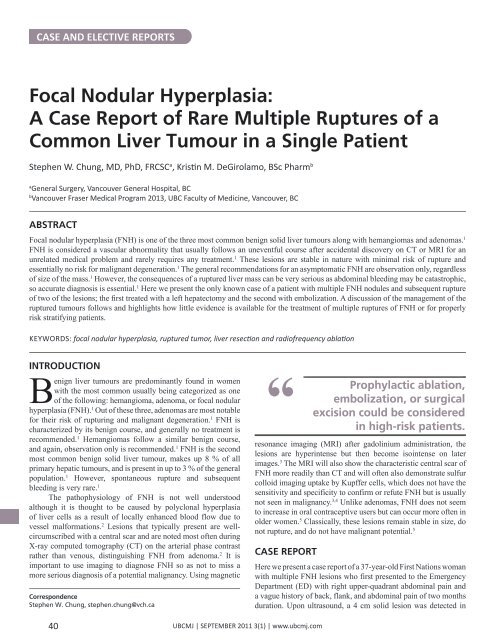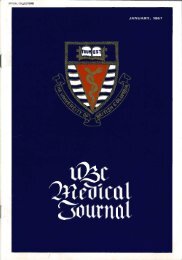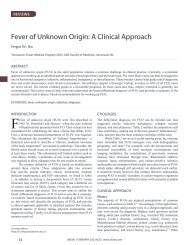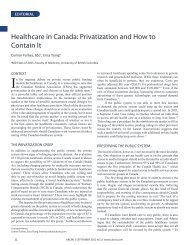Download full PDF - UBC Medical Journal
Download full PDF - UBC Medical Journal
Download full PDF - UBC Medical Journal
Create successful ePaper yourself
Turn your PDF publications into a flip-book with our unique Google optimized e-Paper software.
CASE AND ELECTIVE REPORTS<br />
Focal Nodular Hyperplasia:<br />
A Case Report of Rare Multiple Ruptures of a<br />
Common Liver Tumour in a Single Patient<br />
Stephen W. Chung, MD, PhD, FRCSC a , Kristin M. DeGirolamo, BSc Pharm b<br />
a<br />
General Surgery, Vancouver General Hospital, BC<br />
b<br />
Vancouver Fraser <strong>Medical</strong> Program 2013, <strong>UBC</strong> Faculty of Medicine, Vancouver, BC<br />
ABSTRACT<br />
Focal nodular hyperplasia (FNH) is one of the three most common benign solid liver tumours along with hemangiomas and adenomas. 1<br />
FNH is considered a vascular abnormality that usually follows an uneventful course after accidental discovery on CT or MRI for an<br />
unrelated medical problem and rarely requires any treatment. 1 These lesions are stable in nature with minimal risk of rupture and<br />
essentially no risk for malignant degeneration. 1 The general recommendations for an asymptomatic FNH are observation only, regardless<br />
of size of the mass. 1 However, the consequences of a ruptured liver mass can be very serious as abdominal bleeding may be catastrophic,<br />
so accurate diagnosis is essential. 1 Here we present the only known case of a patient with multiple FNH nodules and subsequent rupture<br />
of two of the lesions; the first treated with a left hepatectomy and the second with embolization. A discussion of the management of the<br />
ruptured tumours follows and highlights how little evidence is available for the treatment of multiple ruptures of FNH or for properly<br />
risk stratifying patients.<br />
KEYWORDS: focal nodular hyperplasia, ruptured tumor, liver resection and radiofrequency ablation<br />
INTRODUCTION<br />
Benign liver tumours are predominantly found in women<br />
with the most common usually being categorized as one<br />
of the following: hemangioma, adenoma, or focal nodular<br />
hyperplasia (FNH). 1 Out of these three, adenomas are most notable<br />
for their risk of rupturing and malignant degeneration. 1 FNH is<br />
characterized by its benign course, and generally no treatment is<br />
recommended. 1 Hemangiomas follow a similar benign course,<br />
and again, observation only is recommended. 1 FNH is the second<br />
most common benign solid liver tumour, makes up 8 % of all<br />
primary hepatic tumours, and is present in up to 3 % of the general<br />
population. 1 However, spontaneous rupture and subsequent<br />
bleeding is very rare. 1<br />
The pathophysiology of FNH is not well understood<br />
although it is thought to be caused by polyclonal hyperplasia<br />
of liver cells as a result of locally enhanced blood flow due to<br />
vessel malformations. 2 Lesions that typically present are wellcircumscribed<br />
with a central scar and are noted most often during<br />
X-ray computed tomography (CT) on the arterial phase contrast<br />
rather than venous, distinguishing FNH from adenoma. 2 It is<br />
important to use imaging to diagnose FNH so as not to miss a<br />
more serious diagnosis of a potential malignancy. Using magnetic<br />
Correspondence<br />
Stephen W. Chung, stephen.chung@vch.ca<br />
“<br />
resonance imaging (MRI) after gadolinium administration, the<br />
lesions are hyperintense but then become isointense on later<br />
images. 3 The MRI will also show the characteristic central scar of<br />
FNH more readily than CT and will often also demonstrate sulfur<br />
colloid imaging uptake by Kupffer cells, which does not have the<br />
sensitivity and specificity to confirm or refute FNH but is usually<br />
not seen in malignancy. 3,4 Unlike adenomas, FNH does not seem<br />
to increase in oral contraceptive users but can occur more often in<br />
older women. 5 Classically, these lesions remain stable in size, do<br />
not rupture, and do not have malignant potential. 5<br />
CASE REPORT<br />
Prophylactic ablation,<br />
embolization, or surgical<br />
excision could be considered<br />
in high-risk patients.<br />
Here we present a case report of a 37-year-old First Nations woman<br />
with multiple FNH lesions who first presented to the Emergency<br />
Department (ED) with right upper-quadrant abdominal pain and<br />
a vague history of back, flank, and abdominal pain of two months<br />
duration. Upon ultrasound, a 4 cm solid lesion was detected in<br />
40<br />
<strong>UBC</strong>MJ | SEPTEMBER 2011 3(1) | www.ubcmj.com










